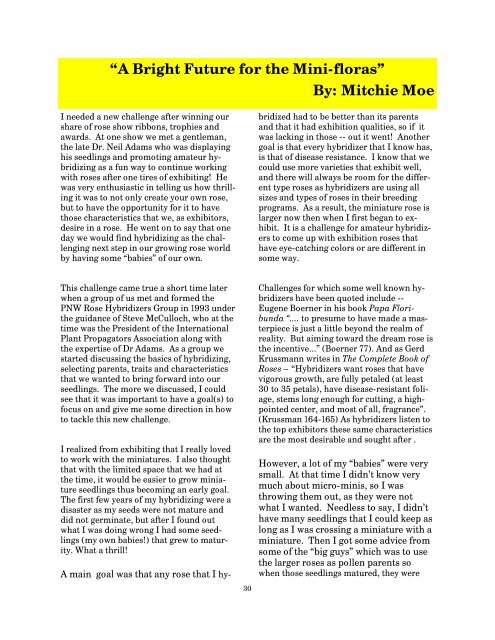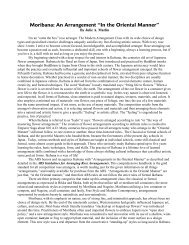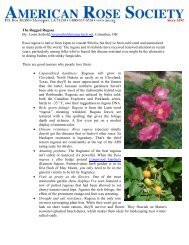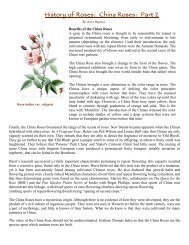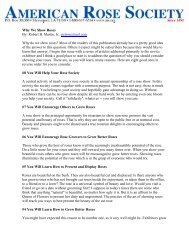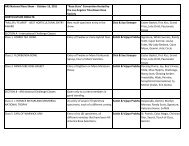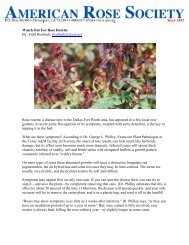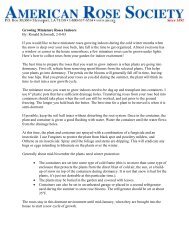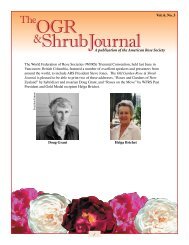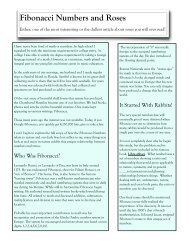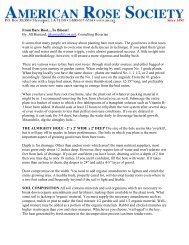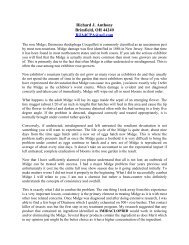Miniature and Miniflora Rose Suppliers - American Rose Society
Miniature and Miniflora Rose Suppliers - American Rose Society
Miniature and Miniflora Rose Suppliers - American Rose Society
You also want an ePaper? Increase the reach of your titles
YUMPU automatically turns print PDFs into web optimized ePapers that Google loves.
“A Bright Future for the Mini-floras”<br />
By: Mitchie Moe<br />
I needed a new challenge after winning our<br />
share of rose show ribbons, trophies <strong>and</strong><br />
awards. At one show we met a gentleman,<br />
the late Dr. Neil Adams who was displaying<br />
his seedlings <strong>and</strong> promoting amateur hybridizing<br />
as a fun way to continue working<br />
with roses after one tires of exhibiting! He<br />
was very enthusiastic in telling us how thrilling<br />
it was to not only create your own rose,<br />
but to have the opportunity for it to have<br />
those characteristics that we, as exhibitors,<br />
desire in a rose. He went on to say that one<br />
day we would find hybridizing as the challenging<br />
next step in our growing rose world<br />
by having some “babies” of our own.<br />
This challenge came true a short time later<br />
when a group of us met <strong>and</strong> formed the<br />
PNW <strong>Rose</strong> Hybridizers Group in 1993 under<br />
the guidance of Steve McCulloch, who at the<br />
time was the President of the International<br />
Plant Propagators Association along with<br />
the expertise of Dr Adams. As a group we<br />
started discussing the basics of hybridizing,<br />
selecting parents, traits <strong>and</strong> characteristics<br />
that we wanted to bring forward into our<br />
seedlings. The more we discussed, I could<br />
see that it was important to have a goal(s) to<br />
focus on <strong>and</strong> give me some direction in how<br />
to tackle this new challenge.<br />
I realized from exhibiting that I really loved<br />
to work with the miniatures. I also thought<br />
that with the limited space that we had at<br />
the time, it would be easier to grow miniature<br />
seedlings thus becoming an early goal.<br />
The first few years of my hybridizing were a<br />
disaster as my seeds were not mature <strong>and</strong><br />
did not germinate, but after I found out<br />
what I was doing wrong I had some seedlings<br />
(my own babies!) that grew to maturity.<br />
What a thrill!<br />
A main goal was that any rose that I hy-<br />
30<br />
bridized had to be better than its parents<br />
<strong>and</strong> that it had exhibition qualities, so if it<br />
was lacking in those -- out it went! Another<br />
goal is that every hybridizer that I know has,<br />
is that of disease resistance. I know that we<br />
could use more varieties that exhibit well,<br />
<strong>and</strong> there will always be room for the different<br />
type roses as hybridizers are using all<br />
sizes <strong>and</strong> types of roses in their breeding<br />
programs. As a result, the miniature rose is<br />
larger now then when I first began to exhibit.<br />
It is a challenge for amateur hybridizers<br />
to come up with exhibition roses that<br />
have eye-catching colors or are different in<br />
some way.<br />
Challenges for which some well known hybridizers<br />
have been quoted include --<br />
Eugene Boerner in his book Papa Floribunda<br />
“.... to presume to have made a masterpiece<br />
is just a little beyond the realm of<br />
reality. But aiming toward the dream rose is<br />
the incentive...” (Boerner 77). And as Gerd<br />
Krussmann writes in The Complete Book of<br />
<strong>Rose</strong>s – “Hybridizers want roses that have<br />
vigorous growth, are fully petaled (at least<br />
30 to 35 petals), have disease-resistant foliage,<br />
stems long enough for cutting, a highpointed<br />
center, <strong>and</strong> most of all, fragrance”.<br />
(Krussman 164-165) As hybridizers listen to<br />
the top exhibitors these same characteristics<br />
are the most desirable <strong>and</strong> sought after .<br />
However, a lot of my “babies” were very<br />
small. At that time I didn’t know very<br />
much about micro-minis, so I was<br />
throwing them out, as they were not<br />
what I wanted. Needless to say, I didn’t<br />
have many seedlings that I could keep as<br />
long as I was crossing a miniature with a<br />
miniature. Then I got some advice from<br />
some of the “big guys” which was to use<br />
the larger roses as pollen parents so<br />
when those seedlings matured, they were


